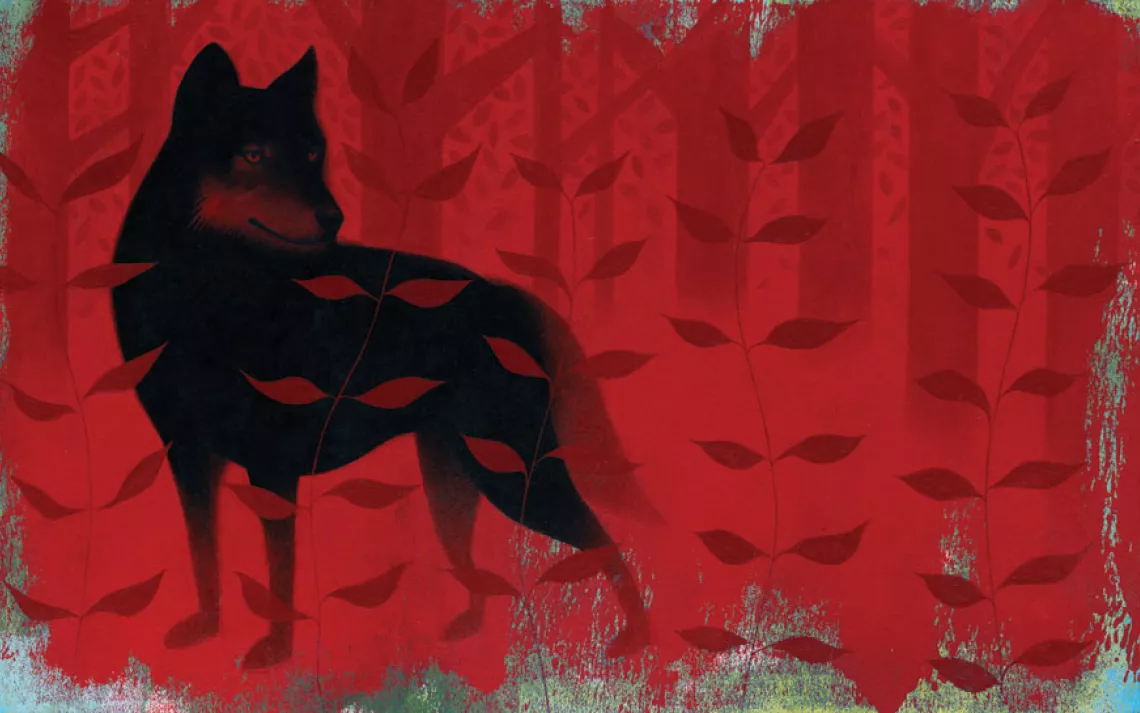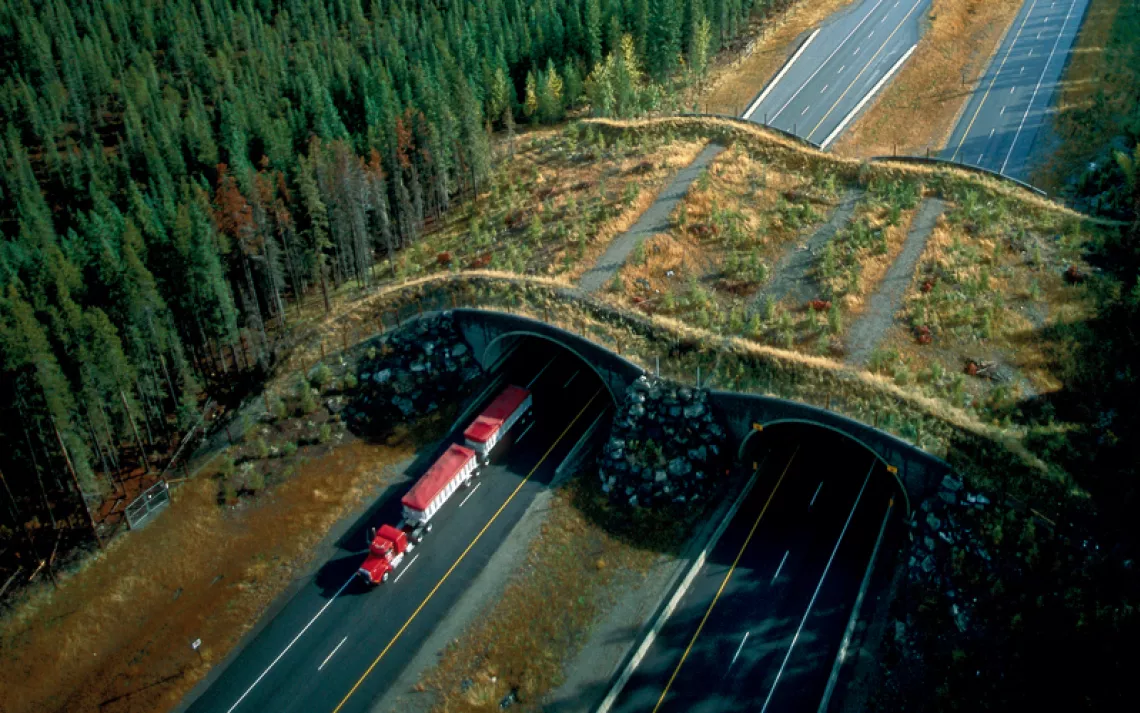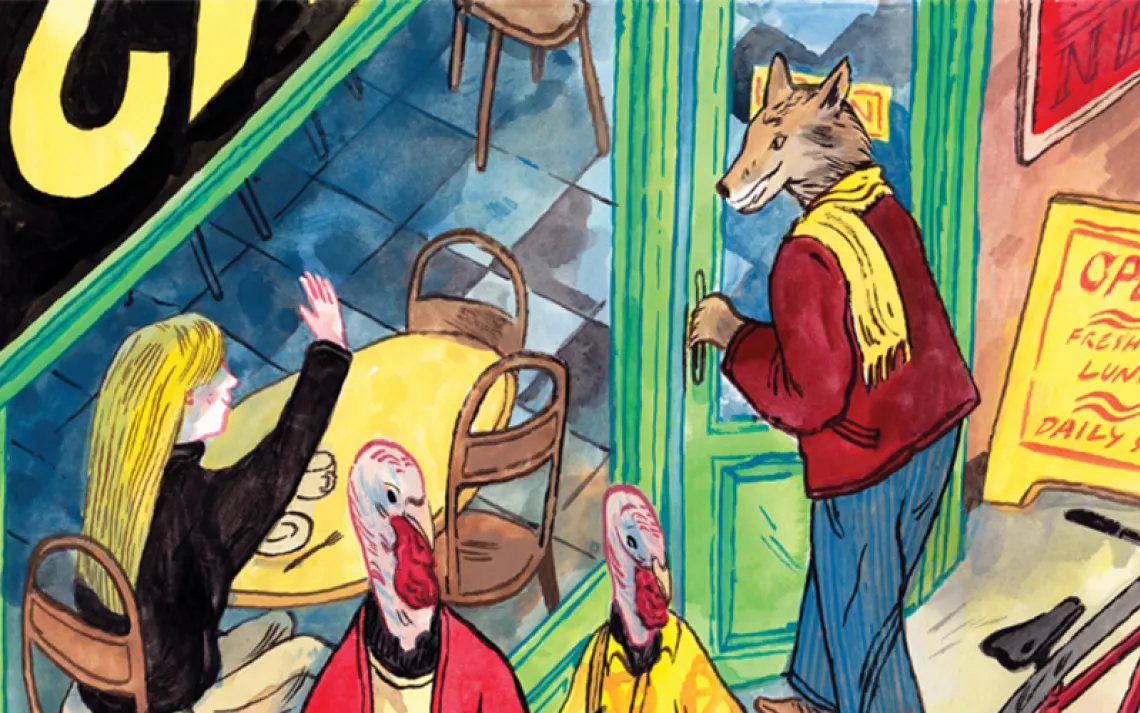To Kill a Wolf
The wolves in my life include one I wanted to shoot

Illustration by Scott Bakal
In September of 2009, the story goes, a black wolf approached an idling truck at a trailhead parking lot north of Juneau, Alaska. A window was rolled down, a .22-caliber rifle was aimed, and the wolf was killed. Two men hefted the carcass into the truck's bed and brought it to a local taxidermist to be skinned and tanned.
Killing wolves in Alaska is commonplace and rarely sparks much of a reaction. The trouble was, this was no ordinary wolf. For six years it had been Juneau's darling, frequenting the edge of suburbia near Mendenhall Lake. It was one of the most photographed "wild" wolves ever.
On a crisp autumn day I attended the black wolf's funeral. A member of a group called Friends of Romeo, formed years earlier to try to protect the Juneau wolf, stood atop a granite boulder and addressed the crowd with his arms spread wide.
"Romeo was a friend," he began. "He was dealt a bad hand of cards when he was born inside the body of a big, bad wolf." A well-known Alaskan author mournfully collapsed, and the next speaker began to recite Sufi poetry. I decided I'd had enough and went for a walk.
Frost had collected on the naked branches of alders, and the silence of the forest was honest and comforting. I wondered if my reluctance to grieve for the wolf resulted from its willingness to interact with sentimental suburbanites. I wanted wolves to be wild, far away from the pettiness of human conventions like funerals. At the same time, no matter how melodramatic the mourners' rhetoric may have been, I couldn't deny empathizing with some of their feelings. Even though when I'd first encountered a wolf, I'd wanted to kill it.
It was 1998, also in October, when large flocks of rock ptarmigan congregate on alpine ridges above Juneau. I had shot a few when clouds settled around me. With an eerie dread, I noticed a shape moving through the swirling fog. A gray wolf materialized, came a few steps closer, sat down, and stared benignly at me and my dog. The wolf was young and emaciated, and it nibbled at browned grass with its massive jaws.
After watching for a while, I began to search for a way down the mountain. The wolf rose and followed. For an hour I wandered in circles, lost in the clouds, before I gave up and hunkered against a boulder. My dog shook against my leg as the wolf sat 50 yards away, staring. I chambered a round into my .22 rifle. The bullet would strike the wolf between the eyes, puncture a small hole in its skull, and destroy enough of its brain to kill it instantly. Only 16 and I would have killed a wolf. I switched off the rifle's safety, the cold touch of the wood stock on my cheek. But as I began to squeeze the trigger, its eyes met mine, and a weight hit me so hard I could barely breathe. I looked after the wolf one last time before the fog swallowed it.
Five years later, I stood on the side of the Alaska Highway trying to hitch a ride to Fairbanks. Two hours passed before I got picked up by an old man who ran a 300-mile trapline off the Yukon River. He asked what I was up to, and I confessed that I'd been wandering around in the mountains for a while. This seemed to make him more at ease, and soon we were talking about hunting, trapping, and wolves.
"I remember one wolf," he said, smiling. "She was pure white, almost as if she glowed. She reminded me of those Arctic wolves you see in National Geographic magazine—the ones that live on those islands off the Arctic coast. She hung around my line for a couple months. I tried every trick I know, but I couldn't catch her in a trap, and she never let me close enough to get a shot at her. In those days, I carried a .243. That gun could really reach out. One day I saw her out around 500 yards across the river. Shot her. Found plenty of blood but never found her. That wolf was the most beautiful I've seen."
Years later I was in the Brooks Range in northernmost Alaska, some of the wildest country left in North America. I was half starved, my nerves shot from encounters with grizzly bears and a sick wolf, and from dealing with the turmoil of a failed relationship. After 700 miles of travel by ski and sandal—a journey that will color my memories for the rest of my life—I was nearing the Noatak Valley. There, two friends would fly in with inflatable boats and together we would float more than 400 miles west, down the Noatak River toward the Chukchi Sea. The remains of a Dall sheep jutted out of a creek, a small grizzly bear mowed blueberry bushes on the hillside, and bands of caribou traversed the mountain's flanks. A strange nervousness came over me as I lightly trod over rocks and tundra with swollen and blistered feet.
"I'm here," I said, standing in the wind and rain, looking out on the expansive valley, washed by pent-up emotion. Floating this river had been a dream I'd shared with a girl I'd spent a good chunk of my 20s with. Or maybe it'd just been mine. A moment later a haunting swell came across the tundra. For a second I was confused. Then it was clear. Wolves, four gray and one white, sat howling on a nearby knoll. I walked toward them. They got quiet for a few moments, and then the big white wolf stood and let loose. Regardless of what they were actually telling me, it felt like they were welcoming me home.
At dusk, after the crowd had dispersed, I stood on the shore where the black wolf's funeral had been held. Across the frozen lake rose the mountain, tinted crimson with alpenglow, where I had first encountered a wolf. I wasn't sure why I had wanted to kill the lonely pup, or why the old man who had given me a ride to Fairbanks had shot the white wolf he'd found beautiful, or why the Brooks Range wolves had called to me when I'd needed it most. Nor was I sure about the mourners' relationship with the black wolf. But I was sure that somewhere in the darkening forest, perhaps resting in a glacial valley or hunting deer on a steep mountainside, were wolves, and for this I was grateful.
 The Magazine of The Sierra Club
The Magazine of The Sierra Club







